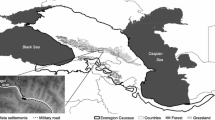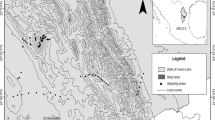Abstract
Against a background of increasing land use intensification on favorable agricultural areas and land abandonment on less arable areas in the Alps, the aim of this investigation was to detect whether and how 10 differently used types of grassland can be distinguished by site factors, plant species composition, and biodiversity. By using a very large number of vegetation surveys (936) that were widely distributed in the Central Alps, site parameters and species composition of the different land use types were compared by discriminant analyses and various biodiversity indices. Results showed that land use is a significant factor affecting the development of different grassland communities with site factors playing a subordinate, yet important role. The 10 land use types studied can be clearly differentiated from one another by single species as well as by species composition. Our study found that the number of plant communities along with the number of species decreases constantly and significantly with increasing land use intensity and on abandoned land. For example, on average, extensively used meadows have more than three times as many species as intensively used meadows. Further, the most even distribution of species (Evenness index) is reached in intensively used meadows, whereas on pastures and abandoned land, some species become dominant forcing other species to recede. The results confirm that due to current trends in agriculture, such as land abandonment and land use intensification, plant diversity in the Alps is decreasing considerably.




Similar content being viewed by others
References
Ackermann W, Durka W (1998) Sort 4.0 Handbuch, Authors edition. München
ASTAT (2002) 5. Landwirtschaftszählung 2000. ASTAT (Autonome Provinz Bozen-Südtirol. Landesinstitut für Statistik), Bozen
Austrheim G, Gunilla E, Ollson A, Grontwentd E (1999) Land use impact on plant communities in semi-natural sub-alpine grasslands of Budalen, central Norway. Biol Conserv 87(3):369–379. doi:10.1016/S0006-3207(98)00071-8
Bahn M, Cernusca A, Tappeiner U, Tasser E (1994) Wachstum krautiger Arten auf einer Mähwiese und einer Almbrache. Verh Ges Okologie 23:23–30
Bätzing W (1996) Landwirtschaft im Alpenraum – unverzichtbar, aber zukunftslos? Europäische Akademie Bozen (ed). Blackwell Wissenschaftsverlag, Berlin
Baur P, Pezzatti M, Rieder P, Schluep I (1999) Langfristige Entwicklung der Agrarstrukturen in Südtirol. Arbeitshefte der Europäischen Akademie Bozen, Fachbereich Alpine Umwelt, Bozen
Baur B, Cremene C, Groza G, Rakosy L, Schileyko AA, Baur A et al (2006) Effects of abandonment of subalpine hay meadows on plant and invertebrate diversity in Transylvania, Romania. Biol Conserv 132:261–273. doi:10.1016/j.biocon.2006.04.018
Beltman B, Van Den Broek T, Martin W, Ten Cate M, Güsewell S (2003) Impact of mowing regime on species richness and biomass of a limestone hay meadow in Ireland. Bull Geobot Inst ETH 2003(69):17–30
Bischof N (1981) Pflanzensoziologische Untersuchungen von Sukzessionen aus gemähten Magerrasen in der subalpinen Stufe der Zentralalpen. Beiträge zur geobotanischen Landesaufnahme der Schweiz 60:1–127
Braun-Blanquet J (1949) Übersicht der Pflanzengesellschaften Rätiens (IV). Plant Ecol 2:20–34. doi:10.1007/BF00132674
Braun-Blanquet J (1964) Pflanzensoziologie, 3rd edn. Springer, Wien
Breitenberger I (2007) Standortfaktoren und Nutzung von ausgewählten Almen in Südtirol. Diploma thesis, Universität Innsbruck
Cernusca A, Seeber MC (1989) Phytomasse, Bestandesstruktur und Mikroklima von Grasland-Ökosystemen zwischen 1612 und 2030 M in den Alpen. In: Struktur und Funktion von Graslandökosystemen im Nationalpark Hohe Tauern. Österreichische Akademie der Wissenschaften, Veröffentlichungen des österreichischen MaB-Programms, vol 13, Universitätsverlag Wagner, Innsbruck, pp 419–461
Cernusca A, Tappeiner U, Bayfield N (eds) (1999) Land use changes in European Mountain ecosystems. Blackwell Wissenschaftsverlag, Berlin
Chemini C, Rizzoli A (2003) Land use change and Biodiversity conservation in the Alps. J Mountain Ecol 7((Suppl)):1–7
Connell JH (1978) Diversity in tropical rain forests and coral reefs. Science 199:1302–1310. doi:10.1126/science.199.4335.1302
Dalla Via J, Tasser E, Tappeiner U, Baric S, Mair V, Kasal A (2004) Biological-ecological fundamentals of mountain hay certification. Laimburg J 1:95–108
Dietl W (1995) Wiesen und Weiden im Berggebiet. Montagna 6:1–6
Ebner C (1996) Die Wiesengesellschaften des oberen Vinschgaus (Südseite) und ihre Bewirtschaftung. Diploma thesis, Universität Innsbruck
Ellenberg H (1996) Vegetation Mitteleuropas mit den Alpen, 5th edn. Ulmer, Stuttgart
Fischer M, Wipf S (2002) Effect of low-intensity grazing on the species-rich vegetation of traditionally mown subalpine meadows. Biol Conserv 104:1–11. doi:10.1016/S0006-3207(01)00149-5
Fischer MA, Adler W, Oswald K (2005) Exkursionsflora für Österreich, Liechtenstein und Südtirol, 2nd edn. Land Oberösterreich, Biologiezentrum der OÖ Landesmuseen, Linz
Giupponi C, Ramanzin M, Sturaro E, Fuser S (2006) Climate and land use changes, biodiversity and agri-environmental measures in the Belluno province, Italy. Environ Sci Policy 9:163–173. doi:10.1016/j.envsci.2005.11.007
Gómez-Limón J, Fernandéz JV dL (1999) Changes in use and Landscape preferences on the agricultural-livestock landscapes of the central Iberian Peninsula (Madrid, Spain). Landsc Urban Plan 44:165–175. doi:10.1016/S0169-2046(99)00020-1
Grabherr G, Mucina L (1993) Die Pflanzengesellschaften Österreichs; Teil II. Gustav Fischer, Stuttgart
Grabner S (1997) Die Bergmähder des Nationalpark Hohe Tauern in Salzburg. In: Bericht über die 2. Pflanzensoziologische Tagung “Pflanzengesellschaften im Alpenraum und ihre Bedeutung für die Bewirtschaftung”. BAL Gumpenstein, pp 109–116
Grabner S, Heiselmayer P (2002) Diversity of mountain meadows in the inner alpine valley Virgental/Eastern Tyrol. Razprave IV. Razreda Sazu 43(3):167–184
Hard G (1976) Vegetationsentwicklung auf Brachflächen. In: Bierhals E et al (eds) (1979) Brachflächen in der Landschaft. KTBL, Schrift
Hill OM (1979) TWINSPAN—a FORTRAN program for arranging multivariate data in an ordered two-way table by classification of individuals and attributes. Cornell University, Ithaca
Hobhom C (2000) Biodiversität. Quelle & Meyer, Wiebelsheim
Hodgson JG, Grime JP, Wilson PJ, Thompson K, Band SR (2005) The impacts of agricultural changes (1963–2003) on the grassland flora of Central England: processes and prospects. Basic Appl Ecol 6:107–118. doi:10.1016/j.baae.2005.01.009
Jacquemyn H, Brys R, Hermy M (2003) Short term effects of different management regimes on the response of calcareous grassland vegetation to increased nitrogen. Biol Conserv 111:137–147. doi:10.1016/S0006-3207(02)00256-2
Jensen K, Meyer C (2001) Effects of light competition and the performance of Viola palustris and on species composition and diversity of an abandoned fen meadow. Plant Ecol 155:169–181. doi:10.1023/A:1013270628964
Knapp G, Knapp R (1952) Über Goldhaferwiesen (Trisetum flavescentis) im nördlichen Vorarlberg und im Allgäu. Printed exerpt from “Landwirtschaftliches Jahrbuch für Bayern” 29(5/6):239–256
Körner C (2003) Alpine plant life—functional plant ecology of high mountain ecosystems, 2nd edn. Springer, Berlin
Marini L, Scotton M, Klimek S, Isselstein J, Pecile A (2007) Effects of local factors on plant species richness and composition of Alpine meadows. Agric Ecosyst Environ 119:281–288. doi:10.1016/j.agee.2006.07.015
Marschall F, Dietl W (1974) Beiträge zur Kenntnis der Borstgrasrasen in der Schweiz. Schweiz Landwirt Forschung 13:115–127
Maurer K, Weyand A, Fischer M, Stöcklin J (2006) Old cultural traditions, in addition to land use and topography, are shaping plant diversity of grasslands in the Alps. Biol Conserv 130:438–446. doi:10.1016/j.biocon.2006.01.005
Mertz P (2000) Pflanzengesellschaften Mitteleuropas und der Alpen. Ecomed Verlagsgesellschaft, Landsberg/Lech
Mucina L, Grabherr G, Ellmauer T (1993) Die Pflanzengesellschaften Österreichs; Teil I. Gustav Fischer, Stuttgart
Myklestad Å, Sætertsdal M (2004) The importance of traditional meadow management techniques for conservation of vascular plant species richness in Norway. Biol Conserv 118:133–139. doi:10.1016/j.biocon.2003.07.016
Newesely C, Tasser E, Spadinger P, Cernusca A (2000) Effects of land use changes on snow gliding processes in alpine ecosystems. Basic Appl Ecol 1:61–67. doi:10.1078/1439-1791-00009
Pasquali G, Bassetti S, Fumai M, Ghirigato I, Morello P, Ruffini FV et al (2002) Erfolgsfaktoren einer Region: Das “Modell Südtirol”. Edition Raetia, Bozen
Pavlů V, Hejcman M, Pavlů L, Gaisler J, Nežerková P, Andaluz MG (2005) Vegetation changes after cessation of grazing management in the Jizerské Mountains (Czech Republic). Ann Bot Fenn 42:343–349
Poschlod P, WallisDeVries MF (2002) The historical and socioeconomic perspective of calcareous grasslands—lessons from the distant and recent past. Biol Conserv 104:361–376. doi:10.1016/S0006-3207(01)00201-4
Rook AJ, Dumont B, Isselstein J, Osoro K, WallisDeVries MF, Parente G, Mills J (2004) Matching type of livestock to desired biodiversity outcomes in pastures—a review. Biol Conserv 119:137–150. doi:10.1016/j.biocon.2003.11.010
Schubiger FX, Dietl W, Bosshard HR (1999) Nährwert von Futterpflanzen und Weiden des Berggebietes. Montagna 6:I–VIII
Spatz G, Weis B, Dolar DM (1978) Der Einfluß von Bewirtschaftungsänderungen auf die Vegetation von Almen im Gasteiner Tal. In: Cernusca A (ed) Ökologische Analysen im Gasteiner Tal. Veröffentlichungen des österreichischen MAB-Programms 2:163–180
Surber E, Amiet R, Kobert H (1973) Das Brachlandproblem in der Schweiz. EAFV, Bericht, p 112
Tappeiner U, Tasser E, Tappeiner G (1998) Modelling vegetation patterns using natural and anthropogenic influence factors: preliminary experience with a GIS based model applied to an Alpine area. Ecol Modell 113:225–237. doi:10.1016/S0304-3800(98)00145-8
Tappeiner U, Tappeiner G, Hilbert A, Mattanovich E (eds) (2003) The EU Agricultural Policy and the Environment. Europäische Akademie Bozen, Fachbereich Alpine Umwelt. Blackwell, Berlin
Tappeiner U, Tasser E, Leitinger G, Tappeiner G (2006) Landnutzung in den Alpen: historische Entwicklung und zukünftige Szenarien. Alpine Space Man Environ 1:23–39
Tasser E, Tappeiner U (2002) Impact of land use changes on mountain vegetation. Appl Veg Sci 5:173–184. doi:10.1658/1402-2001(2002)005[0173:IOLUCO]2.0.CO;2
Tasser E, Mader M, Tappeiner U (2003) Effects of landuse in alpine grasslands on the probability of landslides. Basic Appl Ecol 4:271–280. doi:10.1078/1439-1791-00153
Tasser E, Walde J, Tappeiner U, Teutsch A, Noggler W (2007) Land use changes and natural reforestation in the Eastern Central Alps. Agric Ecosyst Environ 118:115–129. doi:10.1016/j.agee.2006.05.004
Tracy BF, Sanderson MA (2000) Patterns of plant species richness in pasture lands of the northeast United States. Plant Ecol 149:169–180. doi:10.1023/A:1026536223478
Tremp H (2005) Aufnahme und Analyse vegetationsökologischer Daten. Ulmer, Stuttgart
Väre H, Lampinene R, Humphries C, Williams P (2003) Taxonomic diversity of vascular plants in European Alpine areas. In: Nagy L, Grabherr G, Körner C, Thompson DBA (eds) Alpine biodiversity in Europe. Springer, Berlin, pp 133–148
Wallosseck C (1999) The acidophilous taxa of the Festuca varia group in the Alps: new studies on taxonomy and phytosociology. Folia Geobot 34:47–75. doi:10.1007/BF02803076
Wegener U, Reichhoff L (1989) Zustand, Entwicklungstendenzen und Pflege der Bergwiesen. Hercynia NF 26:190–198
Wilhalm T, Niklfeld H, Gutermann W (2006) Katalog der Gefäßpflanzen Südtirols. Veröffentlichungen des Naturmuseums Südtirol. Folio Verlag, Wien-Bozen
Witting B, Richter gen A, Zacharias D (2006) An indicator species approach for result-orientated subsidies of ecological services in grasslands—a study in Northwestern Germany. Biol Conserv 133:186–197. doi:10.1016/j.biocon.2006.06.004
Acknowledgements
We thank Dr. Ruth Willmott, BioScript for the revision of the manuscript, and an anonymous referee for his useful comments. A further thank goes to the Hydrographic Agency of the Autonomous Province of Bolzano/Bozen, South Tyrol for the climate data and the Federal State of Tyrol/Austria for analyzing the soil samples. This work was funded within the framework of the INTERREG-IIIA projects “MASTA” and “DNA-Chip-Entwicklung zur Charakterisierung und Valorisierung von Bergheu.”
Author information
Authors and Affiliations
Corresponding author
Rights and permissions
About this article
Cite this article
Niedrist, G., Tasser, E., Lüth, C. et al. Plant diversity declines with recent land use changes in European Alps. Plant Ecol 202, 195–210 (2009). https://doi.org/10.1007/s11258-008-9487-x
Received:
Accepted:
Published:
Issue Date:
DOI: https://doi.org/10.1007/s11258-008-9487-x




